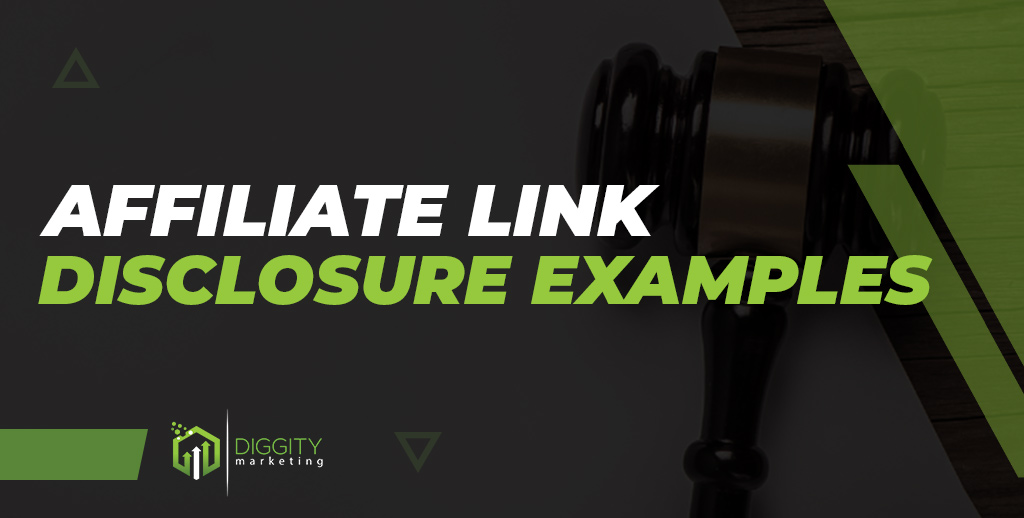
As the affiliate marketing space continues to expand, federal regulators have taken notice. Protect yourself from customer complaints by using one of our affiliate link disclosure examples.
Affiliations between marketers and retailers caught the eye of the Federal Trade Commission in 1972. Three years later in 1975, the Commission would publish the first three sections of the Guides Concerning the Use of Endorsements and Testimonials in Advertising.
As someone who has been following the affiliate marketing space and its regulations closely, I can tell you that it’s important to be aware of federal regulations when it comes to affiliate link disclosure.
These guidelines have governed affiliate disclosures for the last fifty years.
Table Of Contents
- What Is An Affiliate Disclosure?
- Why Do I Need An Affiliate Disclosure?
- Who Needs Affiliate Disclosures?
- How Do I Add An Affiliate Disclosure?
- Where Should I Place My Affiliate Disclosure?
- 11 Affiliate Link Disclosure Examples
- Affiliate Disclosure Tips
- How Do You Write A Disclaimer For Affiliate Links?
- Optimize Your Sponsored Content With Help From The Affiliate Lab
Affiliate disclosures alert website visitors to your business connections.
You must make your affiliate disclaimer clear and conspicuous.
Affiliate disclosures can be as short as one sentence long.
What Is An Affiliate Disclosure?
An affiliate disclosure is a statement on your blog or website informing consumers about your business relationship with the company that sells the promoted products or services.

Most examples of affiliate disclosures are little more than a short blurb that says something like, “I earn commissions from my sponsored links” or “I make money when readers purchase items through my links.”
Marketers include an affiliate disclosure to avoid civil liability for misleading consumers. In online affiliate product reviews, you will often find a disclosure that explains the endorser’s relationship with the company they are selling products for.
Sometimes, the disclosure will explain how the selling company pays the endorser.
Why Do I Need An Affiliate Disclosure?
You need an affiliate disclosure because according to the Federal Trade Commission’s current Guides Concerning the Use of Endorsements and Testimonials in Advertising (2009)[1], also referred to as “the Guides,” you must “clearly and conspicuously” disclose your business relationship.
In a proposed revision of the FTC’s Guides from 2020[2], the Commission offered fresh insight into affiliate disclosures, especially material connections between the endorser and the selling company.
The FTC may see business, family, and personal relationships as material connections. Specific examples of material connections include:
 Monetary payments
Monetary payments Payments in kind
Payments in kind Early access to a product or service
Early access to a product or service Opportunity to win a prize
Opportunity to win a prize Public appearances
Public appearances Print or radio coverage
Print or radio coverage
The Latest Federal Guidance On Affiliate Disclosures

In 2015, the FTC issued the Commission Enforcement Policy Statement on Deceptively Formatted Advertisements[3], which served as an update to the 2009 revised Guides.
The FTC’s Main Principle On Personal Endorsements
The FTC stated that “when the content in which an endorsement is disseminated is not identifiable by consumers as advertising, consumers would not ordinarily expect an endorser to be speaking on behalf of a sponsoring advertiser and such connection must be disclosed to avoid deceiving consumers.”
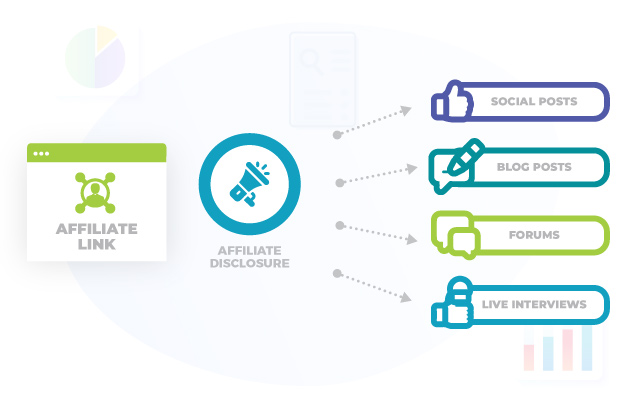
This statement provides guidance for an affiliate link or endorsement placed in:
Social media posts
Blog posts
Online forums
Live interviews
FTC Court Cases Regarding Affiliate Disclosures
Since issuing the Guides, the FTC has presided over several court cases regarding the disclosure of a business connection when making an endorsement.
In Reverb Communications, Inc.[4], 150 F.T.C. 782, 783-84 (2010) (consent), a public relations firm posted reviews on iTunes for its client’s new video game without disclosing their business connection.
Similarly, In the Matter of ADT LLC.[5] (2014) showed us that hired spokespersons must disclose their connection to the endorsed company when delivering a product review on television or the radio.
Who Needs Affiliate Disclosures?
Affiliate disclosures are needed for anyone who endorses, recommends, or reviews a product or service.

Some of the different types of people who need affiliate link disclosures include:
 Celebrities
Celebrities T.V. personalities
T.V. personalities Social media influencers
Social media influencers Affiliate marketers
Affiliate marketers Bloggers
Bloggers Reviewers
Reviewers
How Do I Add An Affiliate Disclosure?
To add an affiliate disclosure, marketers can use one of several established methods, including:
Manually inserting it into each one of your blog posts, emails, or social media posts
Using a widget to automatically add affiliate link disclosures to everything you write
Creating a conspicuous link to a comprehensive affiliate disclaimer page
 Auto Affiliate Links
Auto Affiliate Links Easy Azon
Easy Azon Affiliates Manager
Affiliates Manager Affiliate WP
Affiliate WP Easy Affiliate Links
Easy Affiliate Links Thirsty Affiliates
Thirsty Affiliates
Where Should I Place My Affiliate Disclosure?
You should place your affiliate disclosure close to your recommendation. As of yet, neither the FTC nor any other government body has passed a law that specifies precisely where an affiliate disclosure should go.

However, the FTC has provided some guidance on affiliate disclaimer placement by stating that “the closer it is to your recommendation, the better.”
The requirement that you disclose your affiliate relationship “clearly and conspicuously” implies that you shouldn’t put your affiliate link disclaimer at the bottom of the page because that placement would make it inconspicuous.

To maintain sufficient transparency in a blog post, we recommend placing your affiliate disclaimer before your first affiliate link.
This approach will avoid the situation where a reader clicks the first affiliate link before reaching your affiliate disclosure statement.
11 Affiliate Link Disclosure Examples
Make your affiliate relationships clear to your audience by following the FTC guidelines. As an affiliate marketer, you have likely come across many examples of affiliate link disclosures.
However, we would all like to stay up to date on the latest practices. Crank up your sales volume with some of the best affiliate disclosure examples below.
1. Remodelaholic
Cover all your bases like the comprehensive disclosure page example at Remodelaholic does[6]. Aside from the company’s privacy policy and limitation of liability clause, the page also contains a Sponsored and Affiliate Disclosure section.
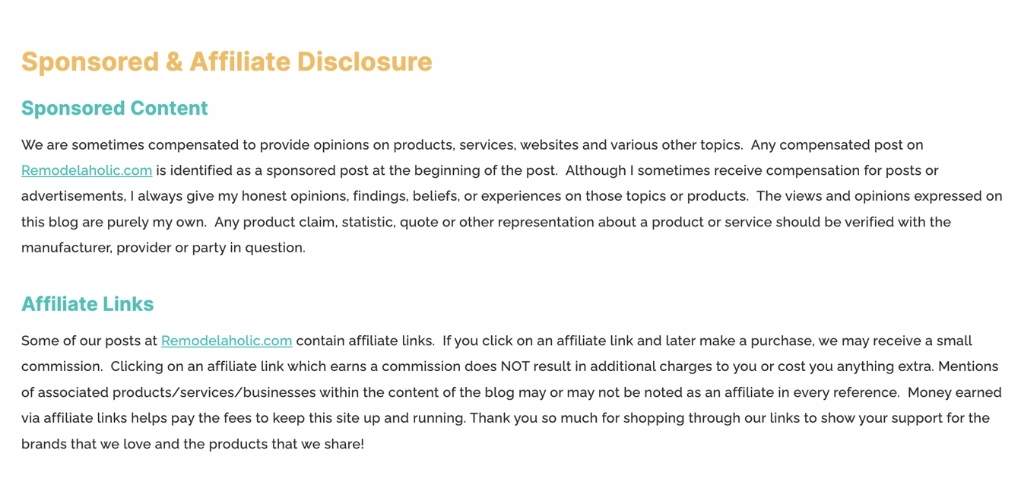
Check it out to see how the owner, Cassity, words her full affiliate disclosure, among other disclaimers.
2. Dan Flying Solo
Dan of Dan Flying Solo does a decent job of inserting his affiliate disclosure to start a blog post[7]. It’s clear. It’s conspicuous. And, it comes before any of his affiliate links.

If we had to point out potential flaws, we might say that Dan could increase the font size of the disclosure. However, we find the disclosure clear and conspicuous based on its location and legibility.
3. Engadget
Engadget’s affiliate link disclosure strategy takes a multi-pronged approach. The company places its affiliate disclosure at the bottom[8] of reviews and links to the Yahoo! privacy policy at the bottom of each web page.
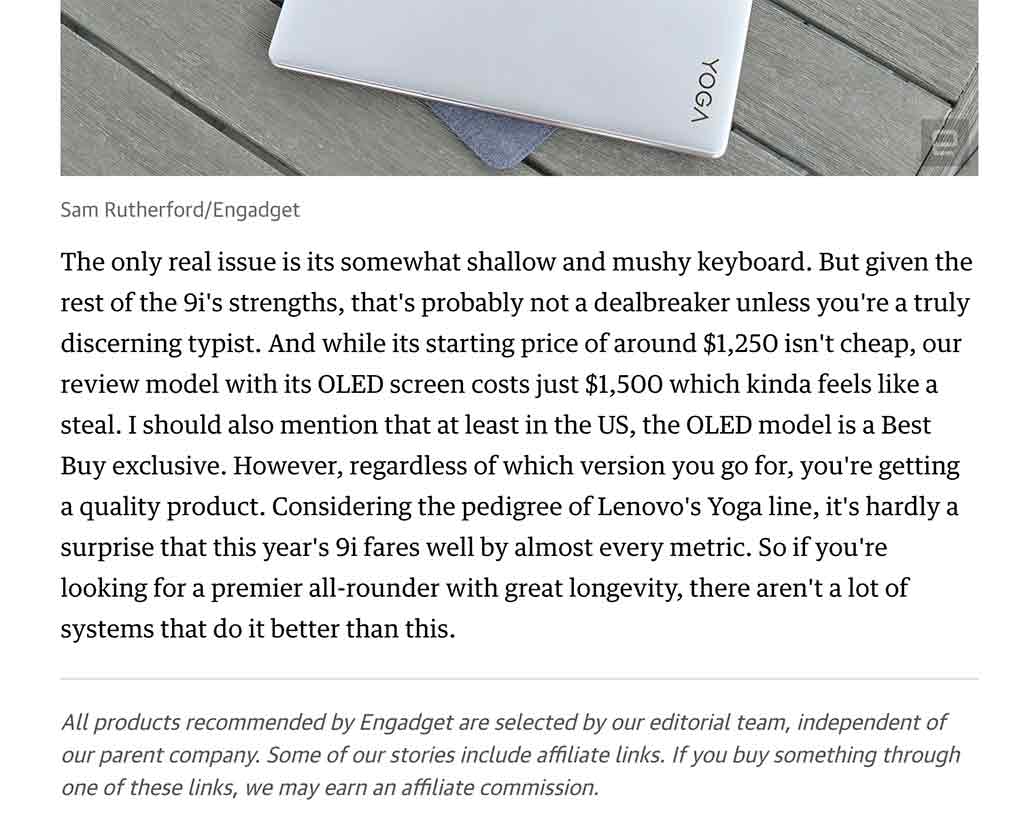
We’d prefer Engadget disclose their business practices before any affiliate links.
4. The Prepared
The good folks at The Prepared place their affiliate disclosure on the side of their main landing page[9]. In fact, they disclose affiliate links in the same way on every page, including blog posts and reviews.
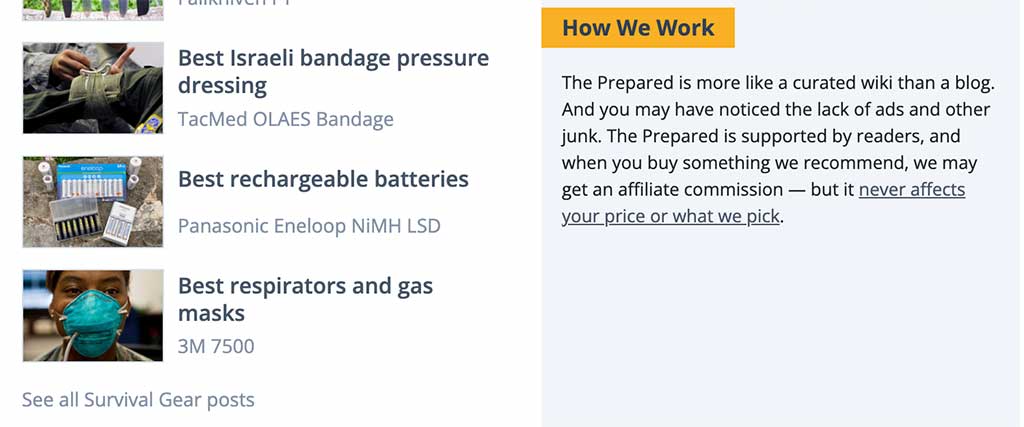
While we appreciate placing affiliate disclaimers on each page, we’d like to see it on the top-left instead of the bottom-right.
5. Outside
To see how an established magazine does business online, visit Outside and have a look around[10]. Outside published its first magazine edition in 1977 and has since moved online.

At first, we felt a little surprised that a decades-old company would insert their only visible disclosure at the bottom of the page. But, then we remembered that Outside remains a popular brand and we should expect a well-connected company to earn money online.
6. Wirecutter
Wirecutter takes the safe approach by placing their short disclosure at the top of reviews and linking to a full disclaimer[12] on a separate page. However, the true genius of their approach lies in how they frame their complete disclosure.

They make their disclosures as part of an “About Us” section, weaving it into a relatable narrative about the company’s mission to establish trust.
7. Tech Radar
Like the previous example, TechRadar keeps it short, sweet, and upfront with a simple affiliate link disclosure[13].

The company created one of the most effective disclaimers we’ve seen by giving credit to their supportive audience, mentioning their use of affiliate links, and offering a link to a longer disclosure.
TechRadar demonstrates how little you actually need to say to cover yourself.
8. SmartBlogger
SmartBlogger ensures the conspicuousness of its affiliate link disclosures by inserting them in pop-ups. The company deploys an affiliate link disclaimer pop-up when the web page loads and another when readers exhibit exit intent.

However, SmartBlogger makes a common mistake by assuming that readers know what an affiliate link is. Then again, most of their audience consists of bloggers who have some familiarity with how affiliate links work.
9. CryptoVantage
See how some website owners struggle to find the right affiliate disclosure by stopping by CryptoVantage. In the past CryptoVantage displayed nothing more than the words “affiliate disclosure” at the top of their reviews.

Readers had to scroll over the text to even see the disclaimer and gain a little clarity. Now, readers must scroll past any affiliate links and reach the bottom of the page to see an updated, more robust disclosure.
We consider CryptoVantage’s approach a work in progress.
10. The DIY Nuts
The couple over at The DIY Nuts does an excellent job of disclosing affiliations inside of their product reviews. The DIY Nuts place this affiliate link disclosure example[14] after the introductory paragraph but before the body.

That makes it virtually impossible for readers to miss. Plus, they offer a link to their privacy policy page for more information.
11. Smart Passive Income
Smart Passive Income (SPI) plays it safe by putting their affiliate link disclosure near the top[15] of their blog posts. However, they stumble into the common pitfall of assuming that their readers know what an affiliate link is.
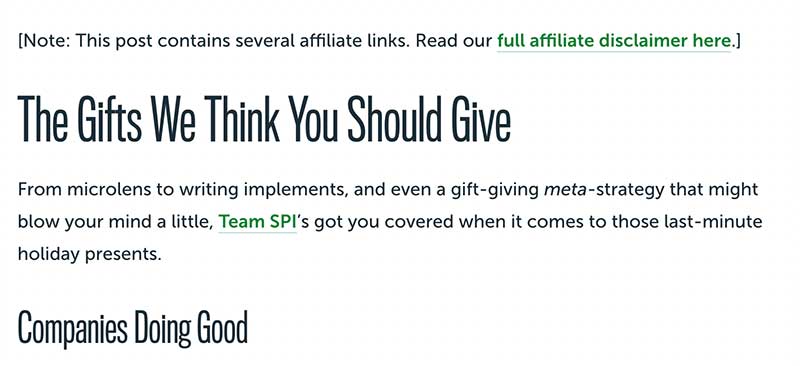
Most visitors would not know that SPI makes a commission on affiliate sales unless they click the disclosure link for more info.
Affiliate Disclosure Tips
With the FTC issuing new guidance every few years, common practices that once proved sufficient now require updates. To help you craft your own, custom affiliate disclosure, we’ve compiled a list of the best affiliate disclosure tips below.
1. Keep It “Clear And Conspicuous”
We’d like to start by reminding you to keep your affiliate disclaimer clear and conspicuous. While it might seem like an obvious tip, that’s precisely why so many affiliates fail to follow the most important of all FTC guidelines.
If you lose focus, you might create a clear but inconspicuous disclosure, like a few of our affiliate link disclosure examples.
2. The Message Is More Important Than The Words
As a legal issue, many affiliate marketers first assume that there must be some magic words to protect themselves. You might encounter required legal language in a contract or a trust, but not in an affiliate disclosure statement.

Instead, the meaning of the words used will determine a disclosure’s effectiveness. Avoid the use of vague or ambiguous language, otherwise known as beating around the bush.
Instead, confirm the existence of affiliate links on your pages, explain that you will make money if your audience uses those links, and mention that readers will not bear any additional cost for purchasing an item through your affiliate links.
3. The Shorter, The Better
In general, an affiliate link disclosure does not require more than a few sentences, unless your affiliate program requires you to use their long one. We have seen several affiliate disclosure examples that meet all of the FTC requirements in one sentence.
However, you may wish to get more creative with your disclosure rather than stick to industry jargon.
Using a second disclosure is the best practice for a website owner who doesn’t want any surprise visits from the Federal Trade Commission.
4. Use Your Disclosure As A Way To Connect With Your Audience
One of the best ways to integrate affiliate link disclosures involves using them to connect with your audience.

Let them know that you use a reader-supported business model, thank them for their patronage, and give a more detailed description of your financial relationship with an affiliate program, like Amazon Associates.
Another approach involves working your affiliate disclosure into a narrative about how you started your business or what your company strives to achieve.
If you can tell a touching story about your humble beginnings or demonstrate how your goals parallel those of your readers, they will jump at the chance to support your affiliate relationship by making a purchase.
5. Affiliate Disclosure Shorthand
Disclose your affiliate links using social media shorthand when working with a character limit. Many affiliate sales start on social media platforms. Yet, some of these platforms limit the size of each post.

On Twitter, for example, you could never make a strong pitch and give full disclosure of your affiliate link in the same tweet. As a result, many social media influencers have resorted to a one-word affiliate disclaimer hashtag.
Some of the best hashtags that social media affiliate marketers use to disclose their affiliate relationships include:
#ad
#promo
#sponsored
#pitch
#plug
We prefer #ad, #promo, and #sponsored, although #sponsored is a tad long for Twitter and can impact the length of your tweet.
6. Understand The Unique Rules For Each Affiliate Program
Depending on which affiliate program you join, you may need to meet additional disclosure requirements. If you partner with multiple programs, they rarely implement the same rules.

Plus, some programs require you to disclose affiliate links in different ways based on whether you pitch in a blog post, social media post, or email. Amazon Associates and other programs demand you use boilerplate language as part of your disclosure page.
Many marketers put all of the language required by affiliate programs on a separate page. It’s not rare to see a disclaimer page with legalese drafted by the high-priced corporate attorneys at Amazon, eBay, and other retailers.
How Do You Write A Disclaimer For Affiliate Links?
To write a disclaimer for affiliate links, you need to focus on revealing your business relationship with the seller. You can do this by mentioning that you may receive a commission for any products or services sold through your sponsored content.
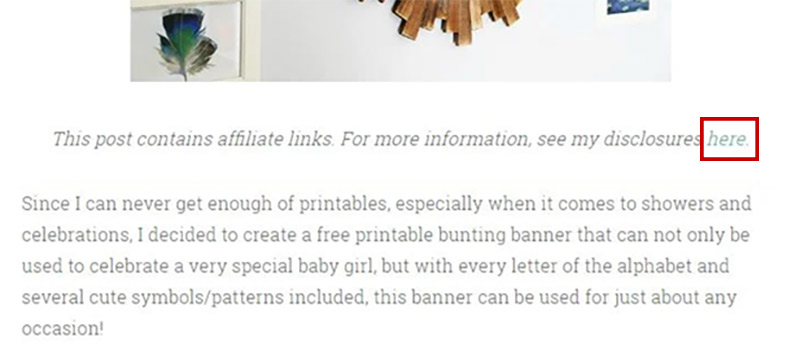
The best practice is to include disclosure links that direct readers to a full disclaimer page.
How Do You Mention Affiliate Links?
To mention affiliate links in the most effective way, inform your readers that they will pay the same amount through your affiliate links. Then, direct them to a resource page if they have any questions.
How Do You Write An Affiliate Disclosure For A Blog?
To write an affiliate disclosure for a blog, create a short narrative about your journey as an affiliate marketer, thank your readers for their continued support, and interlace your story with any disclosures that you need to make.
Optimize Your Sponsored Content With Help From The Affiliate Lab
Now that you know how to craft a clear affiliate disclosure and place it in a conspicuous location, why not rehabilitate some of your old content with proven SEO strategies from The Affiliate Lab?
Our global community of affiliate marketing professionals provides answers to your most pressing SEO questions and supports entrepreneurs making their first forays into the affiliate marketing space.
To learn more about Affiliate marketing including what Google really wants and how to consistently get powerful SEO results watch this free webinar.

